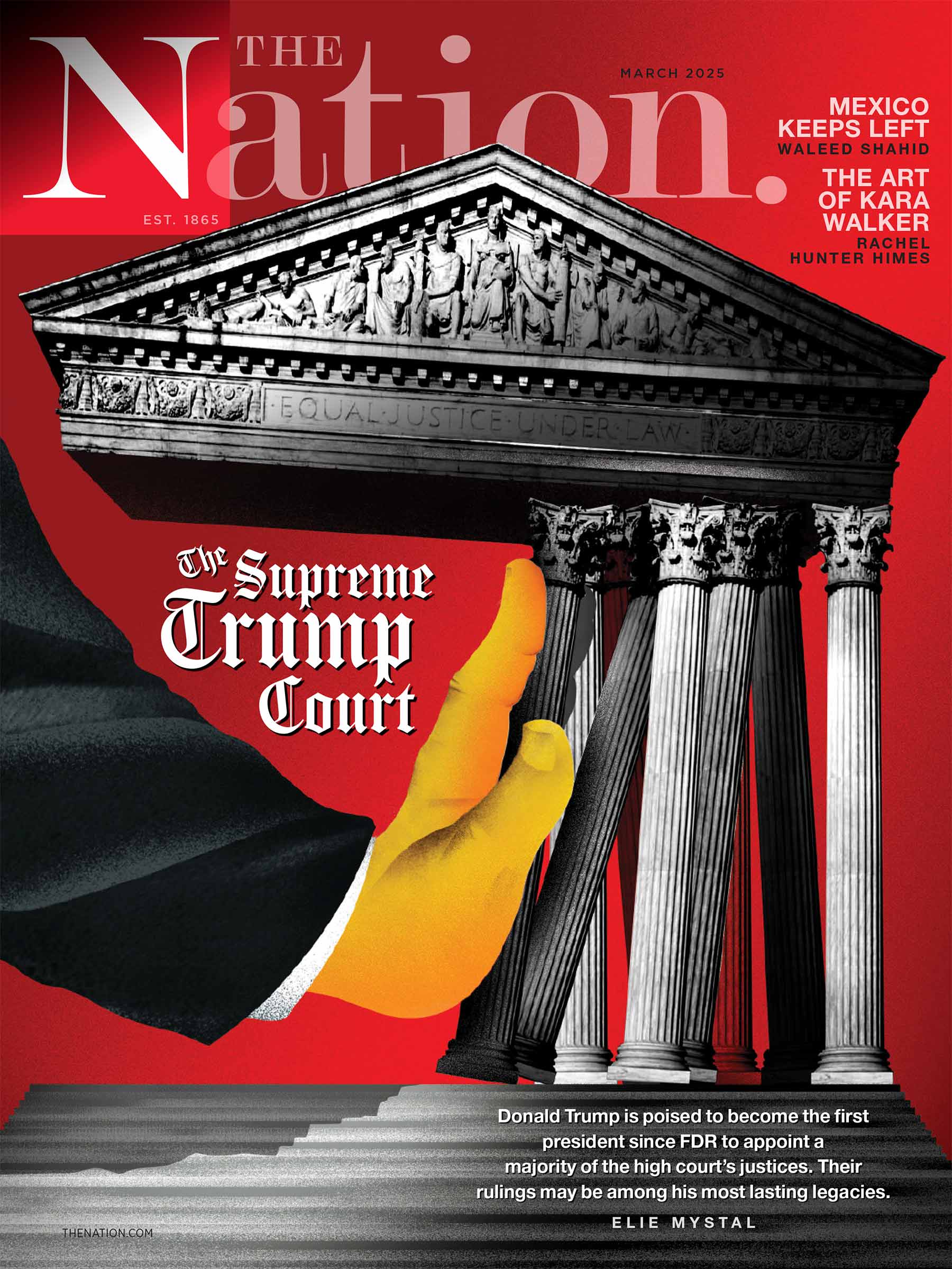To Understand India, Listen to the Pandits of Kashmir
They have been lionized, targeted, exploited, and oppressed for decades. And they have stories to tell.
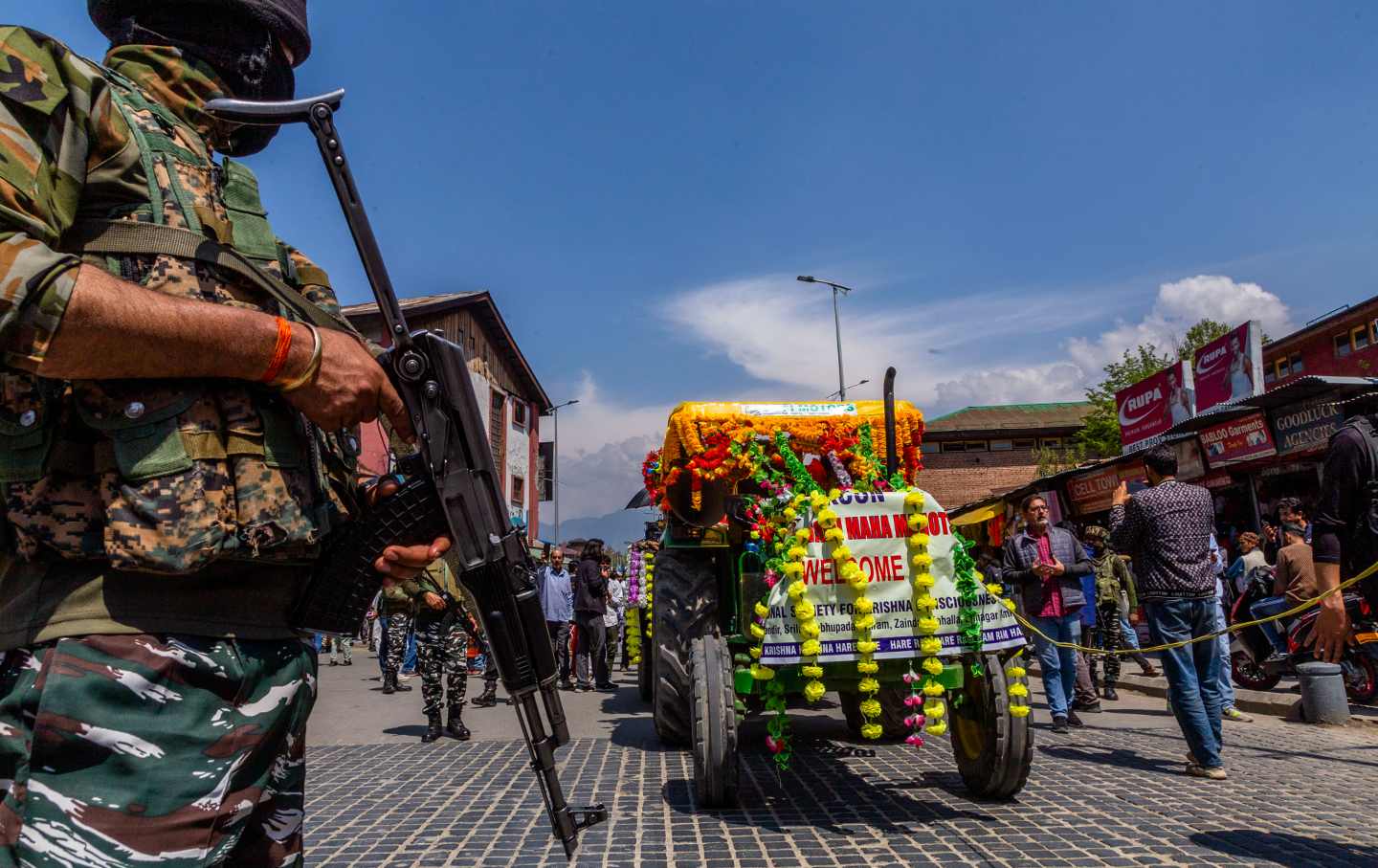
Indian policemen stand guard as Kashmiri Pandits participate in a procession to mark the Ramnavmi festival on April 17, 2024, in Srinagar, Kashmir.
(Yawar Nazir / Getty Images)Samay lives in a town just outside the Kashmiri capital of Srinagar, where the fields are ablaze with saffron. His apartment is part of a walled compound, known locally as a “Pandit colony.” On a Sunday morning this past April, he greeted me at the entrance. Concertina wire and barricades surrounded him.
Inside, soldiers from various parts of India shared space with Kashmiri men, women, and children—426 families in total. A single path divided two long rows of shabby apartments, each just a few rooms. As Samay walked toward the unit he shared with his wife, parents, and children, he pointed out significant structural damage along the roof. In the back of the Pandit colony was a tin shack, where residents were set to fill out their ballots for India’s upcoming parliamentary elections. It would be the biggest democratic exercise in the world, yet it had little bearing on the lives of ordinary Kashmiris. Despite being a government employee, Samay planned to spoil his ballot.
Samay (a pseudonym he requested out of fear for his safety) and his civilian neighbors belong to the Kashmiri Pandit community. They once comprised a religious minority of some 140,000 Hindu Brahmins who lived throughout predominantly Muslim Kashmir. Today, an estimated 6,500 of their original population remain. Pandits have left Kashmir in waves starting in 1947, often to pursue economic opportunities in India as their own position of power within Kashmir’s government began to falter. Emigration peaked in the 1990s amid Kashmir’s armed struggle against the Indian state, as many Pandit leaders—who were allied with the Indian government—were assassinated by rebels. Fearing reprisals, their community left en masse. This event is commonly known as the “Pandit exodus.”
Thousands of Pandits were relocated to destitute refugee camps in the division of Jammu just south of Kashmir’s border. Some remain today. Wealthier families settled throughout India, and eventually, scattered across the world. Samay was 2 years old when his family fled their 16-room mansion in Kupwara to one of the camps in Jammu.
In 2008, Samay returned to Kashmir alongside a small number of other Pandits, under the auspices of Indian government assistance that guaranteed Pandit refugees government jobs and adequate housing. They were first moved into shabby “transitory” housing that was meant to be temporary. Sixteen years later, that housing has become permanent. By most estimations, his complex is a slum. Some might compare it to an army barrack, as the residents live in abject conditions in close quarters with soldiers, and cannot move freely without the coordination of the army.
“In a way, it’s a prison,” Samay said. He and his coworkers are largely confined within the compound walls except to go to work, because of what the army cites as “security concerns.” He relies on Muslim locals for simple tasks. “Our neighbors bring us milk, vegetables, whatever we need,” he said. Though he returned to his homeland after 18 years in exile, he rarely interacts with the society that his family was once a part of.
India’s protracted war on Kashmir has been crucial to galvanizing national unity among the Indian people. Parts of Kashmir are disputed between three nuclear powers: India, Pakistan, and China. Since British decolonization, Kashmir has been the site of three wars between two nuclear powers—India and Pakistan—as well as regular skirmishes with a third, China. According to the UN, the status of both nations’ official claims over Kashmir has remained unresolved since 1948. Both armed and peaceful Kashmiri independence movements have been violently squelched by the Indian central government, while the many factions of Kashmiri separatists were financially backed, at times manipulated, and discarded by the Pakistanis at will. A Kashmir truly independent of either nation is dangerous to both.
Indian-administered Kashmir is the only Muslim-majority territory within its official borders. India’s media has long depicted Kashmir as many things: a breeding ground of antinational Islamic terrorism; a proxy of Pakistan; a rugged tourist destination home to a captive, exoticized people; an uncut gem in the eyes of external industrialists and megadevelopers; latently Hindu despite its Muslim majority; the keystone that holds together India’s national coherence. For many Indians, the idea of Kashmiri independence undermines the definition of the nation itself.
The Kashmiri liberation movement began largely as a class struggle but is crudely framed by pro-India forces as an empty Jiadhi movement of pro-Pakistan shills. The mass migration of Kashmir’s Pandit minority played a pivotal role in rendering the conflict as purely communal rather than one rooted in legitimate aspirations of self-determination. Even if the Pandits are only a sliver of South Asia’s diverse patchwork of Hindu communities, their exodus has been massively exploited by the Hindu right as evidence of an Islamic conspiracy intent on destroying India and Hinduism as a whole. If you want to understand the tactics and the motivations of Indian Prime Minister Narendra Modi and the Hindu nationalist movement he leads, the Pandits are a good place to start.
A certain telling of the Pandit story at the onset of India’s counterinsurgency in the 1990s has captured the imagination of Indians in the subcontinent and beyond—one in which Hindus were simply the victims of genocidal Muslims. But this version is alienated from the political context of the popular uprising, and vests significant responsibility in Muslim civilians rather than in India’s complete destabilization of Kashmiri society. What can be observed, often by Pandits themselves, is that their community’s tragic dissolution has been wielded by Indian politicians and the media to garner public support for the military occupation of Kashmir. Whatever should come after—resettlement or reconciliation—is beside the point. For the purposes of India’s military occupation of Kashmir, eternally dispossessed Pandits are far more valuable than ones who could be meaningfully reintegrated into their homeland.
There are many metrics by which India could measure the efficacy of its occupation. By the number of successful “encounters” with “terrorists,” in which “anonymous gunmen” are “neutralized” by Indian soldiers on a near daily basis. By employment schemes boasted by the Indian government, that allege to improve the life of ordinary Kashmiris, despite the fact that Kashmir’s economy backslid after India revoked its special status in 2019.
In reality, the most meaningful objective of the approximately 1 million soldiers in Kashmir—a number that makes it the most heavily occupied place anywhere in the world—is facilitating safe passage for tourists hungry to experience Kashmir’s alpine terrain. As of May 31, 1.25 million tourists have visited Kashmir. This year is forecasted to break past records.
In the area surrounding Samay’s compound, there are tourists snapping selfies in the saffron fields under the watchful eye of armed vehicles. There are tourists walking the streets of the militarized capital, and there are buses full of tourists weaving through mountain roads toward resplendent meadows skirted around the base of snow-peaked mountains in Pahalgam, known to many as “India’s mini Switzerland.” There are special battalions of soldiers that escort non-Kashmiri Hindu pilgrims to the Amarnath holy site in the Himalayas, while lockdowns are imposed on local Kashmiris, Muslim and Pandit alike.
But traveling in Kashmir is anything but normal. Upon checking into a hotel, one must register their name, profession, contact information, passport number, and reason for visiting. This information, scrawled onto a small xeroxed slip of paper, is passed on to the police. Using a phone out of the bounds of WiFi is tricky. Only certain postpaid SIM cards even work in Kashmir, and purchasing one without an Indian identification card is impossible. Foreign tourists can buy a “tourist SIM card” upon landing in Srinagar, but they typically take days to activate. Moving from place to place is tedious. Even if Srinagar isn’t nearly as congested as more-overpopulated Indian cities, getting somewhere punctually is difficult if your vehicle is stopped and searched multiple times a day.
It was under these limitations—in between bouts of sightseeing as a tourist—that I interviewed the local sources who contributed to this reporting. Kashmiri journalists are not afforded the mobility of someone like me—a foreign tourist, Kashmir’s most cherished and protected class. If not imprisoned, local reporters who deviate from the government’s official communications are intimidated, detained, or executed under suspicious circumstances. Finding Kashmiris like Samay who are willing to criticize the Indian government is extremely difficult, and it often falls on those exiled in the diaspora to speak on their behalf.
“Our story is being used everywhere whether it’s in the film industry or it’s someone just trying to earn money,” he said. “They’re using our pain but they haven’t witnessed our pain.”
In order to appreciate Samay’s circumstances in full, one must first understand the complexities of Kashmir’s political history from the 19th century onward. Like every contested area of the world, the context of Kashmir’s disputed status is far more nuanced than any hegemonic narrative. Every detail of the past matters, and every detail informs how Kashmiris, Indians, and Pakistanis understand the question of Kashmiri sovereignty today.
While most of today’s Pandits are estranged from their homeland, the powerful minority community once wielded significant power in a feudal monarchy. Long before Modi’s political machine sought to transform India into a Hindu ethno-state—long before even the existence of India itself—Kashmir was stratified along religious lines.
Before India and Pakistan declared their independence in 1947, undivided Kashmir was one of several “Princely States” under the British. Princely States were not ruled directly by the colonial empire but rather by local dynasties who made alliances with the British. Kashmir was ruled by the Dogra Empire, non-Kashmiri Hindus who purchased the territory for a cash payment from the British East India Company in 1846. This vast area bleeds across the borders that separate modern India, Pakistan, Afghanistan, and China. In the heart of Dogra Kashmir was the Kashmir Valley, home to a Muslim majority of ethnic Kashmiris, with significant Hindu, Sikh, and Buddhist minorities. Today, when people refer to Kashmir, they usually mean the Kashmir Valley.
Dogra rule was blighted by famine, land expropriation, and the mass bonded labor of Muslim serfs. Kashmir’s local Pandit minority, among other loyalist parties, was granted a privileged status by the Dogra government. Though Pandits and Dogras practiced very different forms of “Hinduism,” many Pandits were employed as debt collectors and landlords, functioning as the public face of Dogra exploitation. This “approximation” that integrated Pandits into the fold of Hinduism still resonates today.
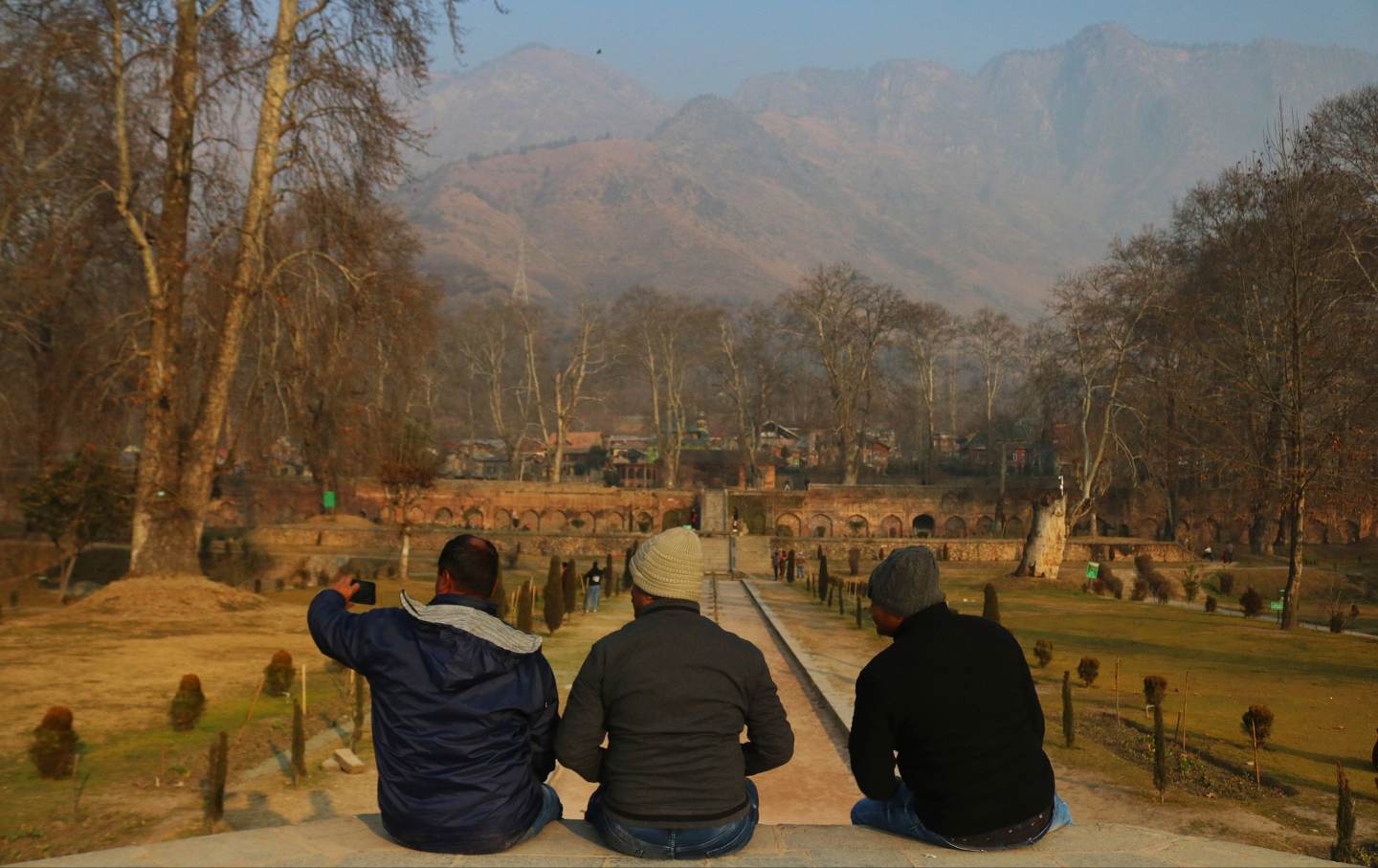
The cruelty of the Dogra regime sowed the seeds of a Kashmiri nationalist movement as British decolonization was on the horizon. Sheikh Abdullah, a young ambitious Muslim who would become Kashmir’s first prime minister, began to mobilize the Muslim majority. Muslim politicians formed the All Jammu and Kashmir Muslim Conference in 1932 to advocate for the rights of Muslims, with the stated goal of cross-religious unity. This organization was eventually expanded to include Hindus, Sikhs, and Buddhists at the behest of future Indian prime minister Jawalharlal Nehru (a Pandit himself) and famed Pandit reformer Prem Nath Bazaz. They rechristened themselves the National Conference (NC) in 1938.
Popular
“swipe left below to view more authors”Swipe →Then came 1947, the year the world split in two. Partition sorted hundreds of millions of former British subjects into two new categories: Indian or Pakistani. Hindus and Sikhs in what is now Pakistan fled to what is now India, and Muslims in what is now India made the opposite journey. One million are believed to have been murdered in orgiastic retributive violence across the subcontinent. Millions more were displaced. Meanwhile, some princely states underwent an equally horrifying parallel process to Partition, known as the “political integration of India.” Some Princely States were annexed into the Indian union by diplomatic pressure, while others were integrated through Indian military intervention. Civilians bore the brunt of this process.
Amid major uprisings against Dogra rule, the last Dogra king, Hari Singh, began to lose control of Kashmir in the autumn of 1947, prompting a series of retributive anti-Muslim pogroms from his army in an attempt to maintain control of the monarchical state. But in the frenzy of the violence, he signed Kashmir over to India. Pakistan disputed this. Thus, India and Pakistan fought their first of three wars over a land and people who were never consulted about whom they belonged to, the same year that both nations were freed from British rule. Shortly after Singh surrendered his throne, Abdullah and the NC were appointed as the emergency interim government per the suggestion of Nehru himself.
The war resulted in a negotiated ceasefire line known as the Line of Control that divided Kashmir into Indian- and Pakistani-administered territories. The UN also called for a plebiscite that would allow Kashmiris to decide on what country they would become a part of. The plebiscite was never honored. The NC affirmed Kashmir’s provisional accession to India under specific stipulations known as Article 370, which allowed the state to have its own Constitution and prime minister. In addition, Article 35A ruled that only permanent residents of Kashmir could own land in the state.
The events of 1947 lassoed Kashmir within the political geography of modern India. The Indian nationalist narrative fashions the first war with Pakistan as one of self-defense in which Indian forces drove out Pakistani infiltrators, sparing the people of Kashmir. Kashmir’s destiny was reduced to a binary: us or them, India or Pakistan, and in a sense, Hindu or Muslim—deterritorializing the indigenous character of Kashmir’s polyethnic and multireligious mosaic, and the very notion of Kashmiri self-determination. In lockstep with India’s mainstream turn toward unabashed Hindu supremacy, the eventual violent dispossession of the Pandits would figure prominently in how the country digested Kashmir’s impending insurgency—or armed uprising, depending on whom you ask.
Kashmir’s coerced ascension into the dominion of India did little to alleviate the fault lines between Pandits and their Muslim neighbors. As a new generation of Muslims began to participate in civic life for the first time, those fault lines grew ever deeper. Despite Pandit perceptions that their access to institutional power would be disrupted by the Muslim uplift, they enjoyed disproportionate representation in Kashmir’s new civil government.
Religious tensions aside, the politics of Kashmir were marred by local corruption and Indian interference. Kashmir would not hold its first honest election until 1977. Sheikh Abdullah was the victor. His ascension came 30 years after his appointment as the first Kashmiri prime minister in 1947. In the intervening period, he had been sacked, arrested, imprisoned, and exiled.
The trouble had begun when Abdullah assumed his ministership after India and Pakistan declared a ceasefire in 1948. He redistributed land from former feudal lords to sharecroppers—among other affirmative action-like initiatives intended to uplift the downtrodden Muslim peasantry. Pandit-dominated political parties felt slighted by the land reforms, and mobilized significant political agitations in the early 1950s, demanding the full integration of Kashmir into India without Article 370. In contrast, Abdullah set up the framework to advance the issue of Kashmiri independence. Nehru arrested Abdullah in 1953.
In 1975, Indian Prime Minister Indira Gandhi (Nehru’s daughter) released Abdullah from prison. He returned to Kashmir as a political candidate in the upcoming election—and won.
Abdullah, like Nehru, dabbled in dynastic politics, grooming his son Farooq to replace him as the head of his party. He died in 1982, and Farooq was elected as Kashmir’s chief minister in 1983. Meanwhile in 1984, mere months before her assassination, Prime Minister Gandhi replaced the governor of Kashmir—B.K. Nehru, her first cousin.
The governor of Kashmir is a parallel role appointed by the Indian central government, that can supersede the authority of Kashmir’s chief minister in times of emergency. The new governor was to be the avowed Hindu nationalist Jagmohan Malhotra, known simply as Jagmohan. Farooq was replaced by his former colleague G.M. Shah in 1984. Jagmohan then dismissed the new chief minister altogether, assuming control of the Kashmiri government. He implemented a series of anti-Muslim reforms. It was also under his governorship that anti-Pandit riots broke out in Anantnag in 1986. Temples were desecrated and homes were burned.
The violence was a single instance in a chain reaction, provoked by an Indian court’s decision to permit Hindu worship within the gates of the Babri Masjid in Uttar Pradesh—but witnesses allege that an Indian Congress politician had organized the violence in an attempt to destabilize his political opponents.
An opposition block comprising the Muslim United Front (MUF) and pro-autonomy parties gained rapid support among the increasingly disgruntled people of Kashmir. In 1987, Farooq Abdullah reentered the NC, while the MUF put forward its opposition candidate: Muhammad Yusuf Shah. A record number of Kashmiris filled out their ballots. Despite his popularity, Shah lost. It is widely believed that the Indian-aligned NC party rigged the election.
This marked a turning point in the subjugation of the Kashmiri public. Shah was arrested and held without charge for nine months. Scores of men crossed over the Line of Control to Pakistani-administered Kashmir to mobilize. They returned with advanced training and weaponry. The pro-independence group Jammu and Kashmir Liberation Front (JKLF) was the first to strike.
The late 1980s through the 1990s marked the height of armed struggle in Kashmir. Militant uprisings and India’s counterinsurgency transformed the physical and psychic landscape of Kashmir. Free movement was restricted. Military vehicles flooded the streets. The once-familiar cinema halls and hotels that residents of Srinagar knew intimately were repurposed as ghoulish torture chambers. Unsuspecting civilians were abducted by Indian soldiers, blindfolded, and subjected to abject horrors for no other reason than their being in the wrong place at the wrong time. Some 8,000 Kashmiris were forcibly disappeared and remain unaccounted for.
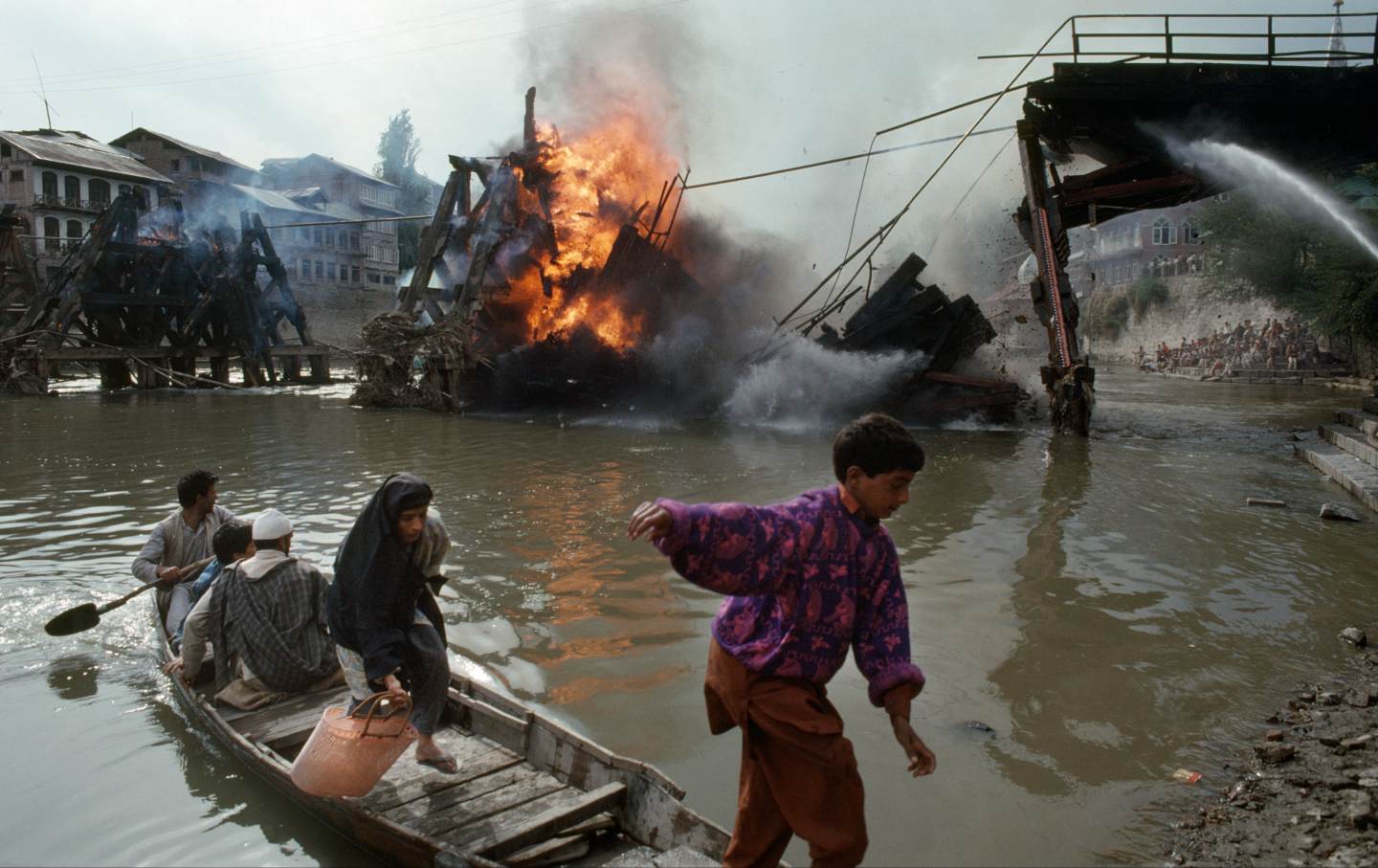
On January 17, 1990, the faltering Farooq Abdullah was dismissed and replaced by Jagmohan, appointed by the central government as Kashmir’s governor. Curfews were imposed. Armed groups carried out hundreds of political assassinations. According to Kashmiri scholar Mohamad Junaid, approximately 200 of the targets were Muslim and 70 Pandit, who disproportionately held government positions as just 3 percent of Kashmir’s total population. “These were not ordinary Kashmiri Pandits who were killed,” Junaid said. “One of them was a judge who sentenced the prominent Kashmiri leader Maqbool Bhat to death.” This contradicts widespread claims by Pandits in India that several civilians were killed openly on the basis of their religion.
On January 19, the Indian army marched into Srinagar. The night began with violent crackdowns. Hundreds of Muslims and Hindus were forced out of their homes by soldiers and beaten. The prominent Pandit leader Sanjay Tickoo, whose family never left the valley, attested that slogans threatening Pandit women were recited by demonstrators in the streets and that hit lists detailing the information of Pandit and Muslim politicians circulated. Kashmiri Hindus “felt completely unsafe in this environment,” Junaid said, prompting thousands of Pandits to pack their belongings and evacuate as the fighting was about to intensify dramatically.
It is impossible to write about the night of January 19 with absolute certainty. Crucial details of the exodus remain disputed, as an official investigation has been blocked by the Indian army. Many Kashmiris (including some Pandits) claim that the displacement was orchestrated by Jagmohan himself, to give the Indian army “free rein” to descend upon the Muslim population of Kashmir with no Hindu casualties. Others frame it purely as an anti-Hindu genocide whose primary perpetrators were Islamist terrorists (though the majority of the killings were carried out by the secular JKLF), the army’s presence notwithstanding.
The exact number of Pandit fatalities over the next decade is also up for fierce debate and ranges from a state estimate of 219 to claims of multiple thousands. “There are a lot of nuances, but the fact remains that the Indian government has not opened these cases,” said Junaid. Finding reliable data is extremely difficult.
What is clear is that the exodus did not occur in a single night. Pandit families continued to leave Kashmir in the coming months. There were also families who decided to stay, risking becoming the Hindu “collateral damage” that many believe Jagmohan was trying to prevent. January 19 would later be known as the anniversary of the Pandit tragedy, commemorated around the world. This is a noteworthy framing of history, given that January 19 also marked the beginning of India’s counterinsurgency waged against the people of Kashmir valley as a whole—Muslims, Sikhs, and those remaining Pandits. While the Kashmir valley was besieged, the least economically privileged of the Pandits were neglected in squalid refugee camps for years.
“They were left there by the Indian government, never given proper accommodations, and used to have international reporters take their pictures and show that the Kashmiri movement was an Islamist struggle to drive Hindus out,” said Junaid. “If that had been the case, with the exodus achieved, why would the movement continue?” he asked, hypothetically. The Indian government made multiple promises to facilitate a Pandit return to no avail. “Many of their children who do not remember the coexistence with Kashmir’s Muslims grew up radicalized by the Hindu right wing.”
The forced separation of Pandits from Muslims would have a profound effect on Kashmir. Many young Muslims, languishing under the thumb of India’s occupation, only knew of the Pandits through the stories that their parents told them—as if they were ghosts. The many thousands of Pandits who left Kashmir as children assimilated to Indian culture by necessity. This process estranged them from their own Kashmiri identity or memory of interfaith contact, thwarting meaningful solidarity with Muslim Kashmiris.
Mona Bhan, a Pandit scholar who spent part of her childhood in Jammu after the exodus, recalled how the state was invested in homogenizing a pan-Hindu identity among displaced Pandits. “There were these posters and stickers distributed among Kashmiri Pandit households that said ‘be proud of your Hindu identity.’… Suddenly I felt like the community was geared toward adopting more Hindu practices that aligned them with India rather than a distinct Kashmiri Hinduism,” she said.
A movement to establish a Pandit state called Panun Kashmir (Our Own Kashmir) emerged in the early 1990s. Panun Kashmir made international headlines in 2019 when a senior Indian diplomat proposed Israel as a blueprint for establishing a Pandit ethno-state in Kashmir. Bhan said that the Pandits who grew up in the shadow of the exodus tend to paint all Kashmiri Muslims as terrorists compared to their parents, whose relationships with their Muslim compatriots were far more textured and complex.
“They grew up with an inherited sense of victimhood…and that inherited victimhood can become more toxic.”
“There were horrible scenes everywhere,” said Manav (another pseudonym). Manav, like Samay, is a Pandit government worker who returned to Kashmir and lives in an armored colony. His recollection of the day his family left Kashmir was harrowing. “A professor who lived in our neighborhood was killed by his own students.” He was 7 years old. When they reached Jammu, they were moved into a tent.
Like every Pandit émigré, Manav’s account is laden with personal anguish. But what makes him unique is his decision to come home. Only a sliver of the Pandit diaspora has done the same. With a direct stake in the future of Kashmir, he prefers not to dwell on the events of the 1990s. “That was the past, so we should look forward and reconcile things if we really want peace.”
However, many distorted representations of the exodus—through cinema, memoirs, and journalism—are intent on cementing that past as an omen for all of India’s future, if Kashmir is not properly subdued. According to Bhan, it is the hegemonic voices of radicalized Pandits in the diaspora that dictate the exodus narrative. Depictions of the exodus as an ethnic cleansing or genocide—for which the entire Muslim population of Kashmir is held accountable—have come to shape popular opinion about India’s actions in Kashmir. The voices of Pandits currently in Kashmir are often overlooked.
Perhaps the single most consumed piece of media about Kashmiri Pandits in recent years is the Indian blockbuster film Kashmir Files. Purporting to draw on interviews with 700 “survivors and historians,” the film depicts the plight of the Pandits in the 1990s with stunning inaccuracies. Prime Minister Modi endorsed the film, and the RSS celebrated it as revealing the “real tragedy” of the Kashmir Pandits. Jingoistic fanatics chanted Islamophic slogans in the theaters.
The Kashmir Files is laden with scenes of violence so lurid it veers on parody, and demands the use of “genocide” to describe the events of the 1990s—a designation that is contested by many journalists and historians. The Muslim villains, supposedly members of the JKLF and other armed groups, are cartoonishly evil, eyes thick with kohl as they shoot at anything that moves. Muslim civilians and militants are portrayed as equally culpable. In comparison to the militants, criticism of the Indian army’s responsibility for the Pandit mass displacement is almost entirely absent. Kashmiri self-determination is therefore synonymous with an assault on the Pandits and India as a whole. While some Pandit audiences described watching the film as a “cathartic” experience, others delivered searing criticism of the film’s nakedly Islamophobic agenda.
The film regurgitates a manipulative historical narrative in which Pandits are the only “Indigenous” inhabitants of Kashmir that survived several attempts by Muslim “invaders” to cleanse them from their land. The indigenous Pandit becomes a proxy for the Indian state. Kashmir’s millions of Muslims are merely interlopers.
“Kashmiri Pandits who have been displaced will obviously long for home and remember the trauma,” said Kashmiri feminist scholar Nitasha Kaul, an overseas citizen of India who was recently denied entry to the country by the government, in retaliation for her extensive academic work on the disintegration of democracy in India. Kaul had testified at the US Congress in 2019 on the human rights situation in the region following India’s revocation of constitutional autonomy in Kashmir. Kaul contextualized films like The Kashmir File within Hindutva’s larger “Islamophobic project,” making mention of India’s discriminatory citizenship act and recent revisions to textbooks.
“This gets no one justice,” she said. “What this does is just prolong everyone’s traumas, deepen the divides, makes this a communal issue rather than a political issue…to create an industry out of selective traumas like Bollywood was done is of course problematic.”
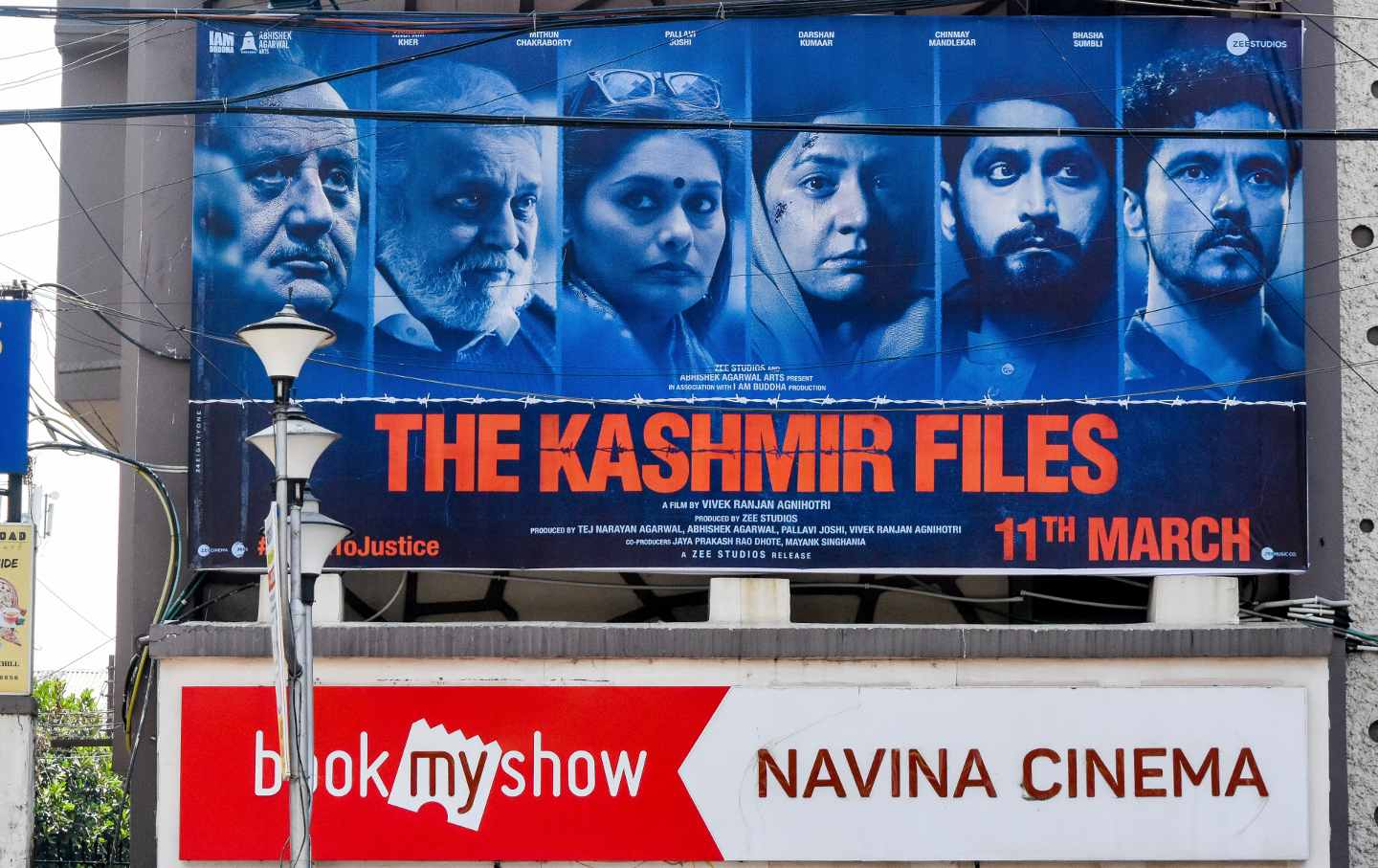
In 2006, following nearly 20 years of violence (including one all-out war in 1999), India and Pakistan tried once again to discuss a resolution to Kashmir. Any implementation of the resolution was quickly frayed by the call-and-response pattern between the Indian counterinsurgency, armed groups’ continued attacks in Kashmir and India, further retaliations, and the peoples’ mass mobilizations.
Around this time, a few thousand Pandits were preparing to return to Kashmir as Indian government workers, under the hospices of a reconciliation and rehabilitation measure to bring the displaced community back to the valley. Samay and Manav were among them. With the hopes of revitalizing their ancestral connection to Kashmir, they crossed the Pir Panjal Range that separates Jammu from the Kashmir Valley. With the support of the Indian government, they were moved into camps once more.
Manav described his current apartment as “a simple two rooms, kitchen, and bathroom,” home to eight family members. He refers to the Pandit colony he’s lived in for the past 14 years as a “transit camp.”
The “resettlement package” was not an ordinary government scheme. “It was part of a relief and reconciliation process,” said Manav, who hoped his return would set up the framework for other Pandits to salvage their community’s presence in the Valley. However, there were concerning issues with his contract. “There have been so many draconian orders for the job. We have to sign a bond that we will never leave the Valley, whatever the conditions may be,” with no possibility of promotion or transfer. This has serious implications for many of his colleagues, whose entire families live in Jammu where they were first resettled after the exodus. “This was basically a plan to trap us,” Manav said.
After enduring years of neglect and corruption, Manav’s community hoped that Modi’s Bharatiya Janata Party (BJP) would finally meet their demands after Modi was elected in 2014. The BJP explicitly promised to resettle the Pandits in its 2014 and 2019 manifestos. “Things have not been moving in the right direction,” he said. “God knows, 10 years have passed now.” In emotional terms, the Pandits are often described as the victims of a “forgotten” genocide, despite how frequently their story is told in the Indian political arena. What does it mean then, that for the first time ever, the Pandits were never mentioned—perhaps forgotten—by the BJP in their latest election manifesto?
The incendiary promise that the BJP did keep was the abrogation of Article 370. In 2019, the Indian Parliament shocked the world when it officially stripped Kashmir’s semiautonomous status originally enshrined in the Indian Constitution in 1947. The army descended upon the valley, imposing violent crackdowns, media and Internet blackouts, unlawful killings, mass arrests of journalists, local politicians, and human rights workers. An integral feature of Article 370 was article 35A, which guaranteed that only Kashmiri residents were permitted to purchase land. After it was revoked, resource-rich Kashmir entered the market for external buyers and industrialists. This set up the framework for what many scholars identify as a new phase in India’s settler-colonial regime in Kashmir.
Twenty nineteen’s sudden upheaval provoked a wave of assassinations. As in the 1990s, Pandit government workers were targeted by armed resistance groups. In May of 2022, a man named Rahul Bhat was shot in his office by two LeT gunmen. Many Pandit workers either fled or requested to be relocated to Jammu. Their demands were met with a cynical response from Lieutenant Governor Manoj Sinha, who said that their salaries would be withheld so long as they “sit at home.” The murder of Pandit workers—and the Indian government’s unmoved response—reopened old wounds. Bhat’s family accused the BJP-led government of using young Pandit workers as “cannon fodder.”
Manav’s contract already compelled him to stay in Kashmir, no matter then danger. Since the recent wave of targeted killings, he and his colleagues’ movements are even more restricted. They are closely monitored by soldiers when they leave the colony to go to work or a rare trip to the market. They cannot leave the transit camp after 5 pm. Their entire families are subjected to the same draconian rules.
Like Manav, Samay worried about the effect this has on his children. “Life here is very slow.… Even the kids don’t get much exposure to the outside world, poor things,” he said.
Manav’s frustration with the BJP’s ambivalence is only augmented by how little they interact with Muslim Kashmiris beyond the walls of their compound. “If we cannot move freely, how can I tell my children to return?” he asked over the phone. We had been set to have an in-person interview but he backed out, saying he was too scared to proceed.
The same day, another source—a Pandit government worker—went quiet. There was a military raid near his home in Shopian after a “nonlocal” taxi driver from Delhi was shot in his car. During raids, entire neighborhoods are cordoned off by soldiers. Many civilians turn off their phones. The only accounts of what happens that reach the media are tightly controlled by official military sources.
Why did you stay? Sanjay Tickoo does not have a satisfactory answer to the question that countless people have asked him since 1990. “In the early ’90s, every Kashmiri fell under two guns,” he said. “The state asked me why I didn’t leave—I was accused of sheltering terrorists.”
A former pharmaceutical worker, Tickoo is now the president of the Kashmir Pandit Sangharsh Samiti (KPSS), a local advocacy group that addresses the concerns of the few thousand Pandits who stayed back in the Valley. While the Hindu nationalist narrative of Pandit question remains fixed on the year 1990, time did go on. Like all Kashmiris, Tickoo’s community endured the complete militarization of life from the days the Indian army first besieged the Kashmir valley up until the present.
“We don’t show any party mercy whether it is state or non-state actors, Modi or a tehreek chief,” said Tickoo.
The KPSS’s politics is hard to categorize within a clean framework that privileges either Kashmiri autonomy or complete Indian integration. Perhaps this underlines the extremely particular situation that these Pandits have been thrust into: historically allied with a national body that the majority of Kashmiris deem as illegitimate, yet completely disregarded by that government and at times scapegoated. Pandits who left are part of the religious majority of India, but those who stayed are a minority in Kashmir, embodying a kind of conceptual privilege and material non-privilege simultaneously.
Tickoo is abundantly clear in his criticism of the BJP’s rule over Kashmir, and in past interviews, he has assailed the abrogation of Article 370—an effort championed by Pandit and Hindu lobbies in the United States. As recently as May, Tickoo refuted an Indian minister’s claim that tens of thousands of Pandits returned to Kashmir after 2019. What he does believe resolutely is that Pandits are being retaliated against for the actions of India’s central government, and that the BJP’s repression of civil society is preventing well-meaning non-Pandit Kashmiri masses from mobilizing on behalf of his community. Tickoo describes the post-abrogation years as an echo of 1990.
For this reason, Tickoo lives in a securitized lockdown of his own, with personal bodyguards in a discreet location. Though he doesn’t live in a Pandit colony like Manav and Samay, he relies on the same security apparatus to travel, coordinating with the police to move from village to village. “It is more unsafe now than it was in the ’90s,” Tickoo said ominously. “Ultimately in 5–10 years, I don’t think you’ll be able to find a KP left in the Valley.” For now, Tickoo believes that the BJP’s priority is not to foster a safe environment where the whole of Kashmiri society can thrive, but one that is safe enough for the millions of Indian tourists who ogle at Kashmir’s mythical beauty every year—even if the landscape is marred by bunkers, tanks, and snipers.
Beyond the soldiers themselves, reminders of India’s violent chauvinism are everywhere in Kashmir today. Billboards that celebrate the triumphs of Rashtriya Rifle and other battalions mark the numerous army bases wedged between houses and business on quiet residential streets. Along the freeway are memorials to fallen Indian soldiers referred to as “martyrs,” likening them to those slain Kashmiris laid to rest in Srinagar’s Mazar-e-Shuhada (Martyrs’ Graveyard). Even within Kashmir’s oldest Hindu temple, Sri Shankaracharya, images of soldiers compete with the divine. Next to the main shrine is a massive poster emblazoned with the words “GLORIES OF CRPF” (Central Reserve Police Force). The promotional sign is checkered with photographs documenting Indian military operations in Kashmir and other “unstable” parts of the subcontinent: the insurgency-prone states bordering Bangladesh and Burma, civil war–torn Sri Lanka, and the jungles of the south held by Maoist revolutionaries. The most conspicuous photo shows officers posing behind the corpses of “foiled terrorists” after the attempted 2005 temple bombing in Ayodhya. Shankaracharya is an indispensable site of Pandit heritage. Yet, these days, the Hindus that gaze upon the idols of soldiers and Shiva, the security personnel and tourists they frisk, are mostly non-Pandits.
For Samay, these displays of the army’s might mean nothing. “No matter how much security is deployed on our behalf, we have to coexist with the locals—nothing else will work,” he told me. Speaking over a cup of salted pink tea, he had a curious way of framing his own spatiality in Kashmir, as if a part of him were still on the outside looking in. “Bridging the gap between Hindus and Muslims doesn’t just happen through talking,” he said. “It needs to happen through groundwork, and only then can we return.”
More from The Nation
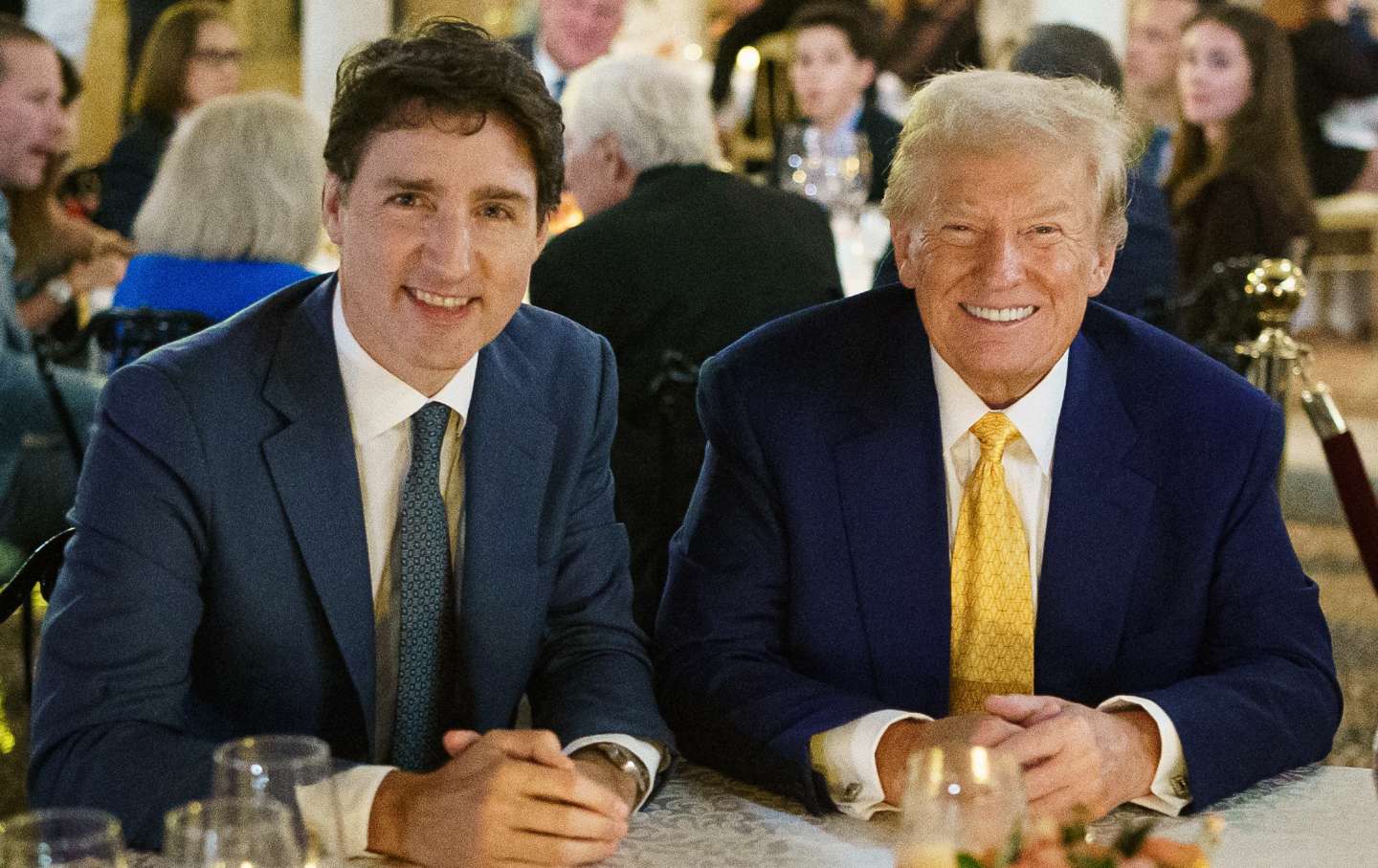
Trump’s 51st-State Plan Would Be a Literal Death Sentence for Canadians Trump’s 51st-State Plan Would Be a Literal Death Sentence for Canadians
Canadians have a universal healthcare system and significantly longer life expectancy than Americans.
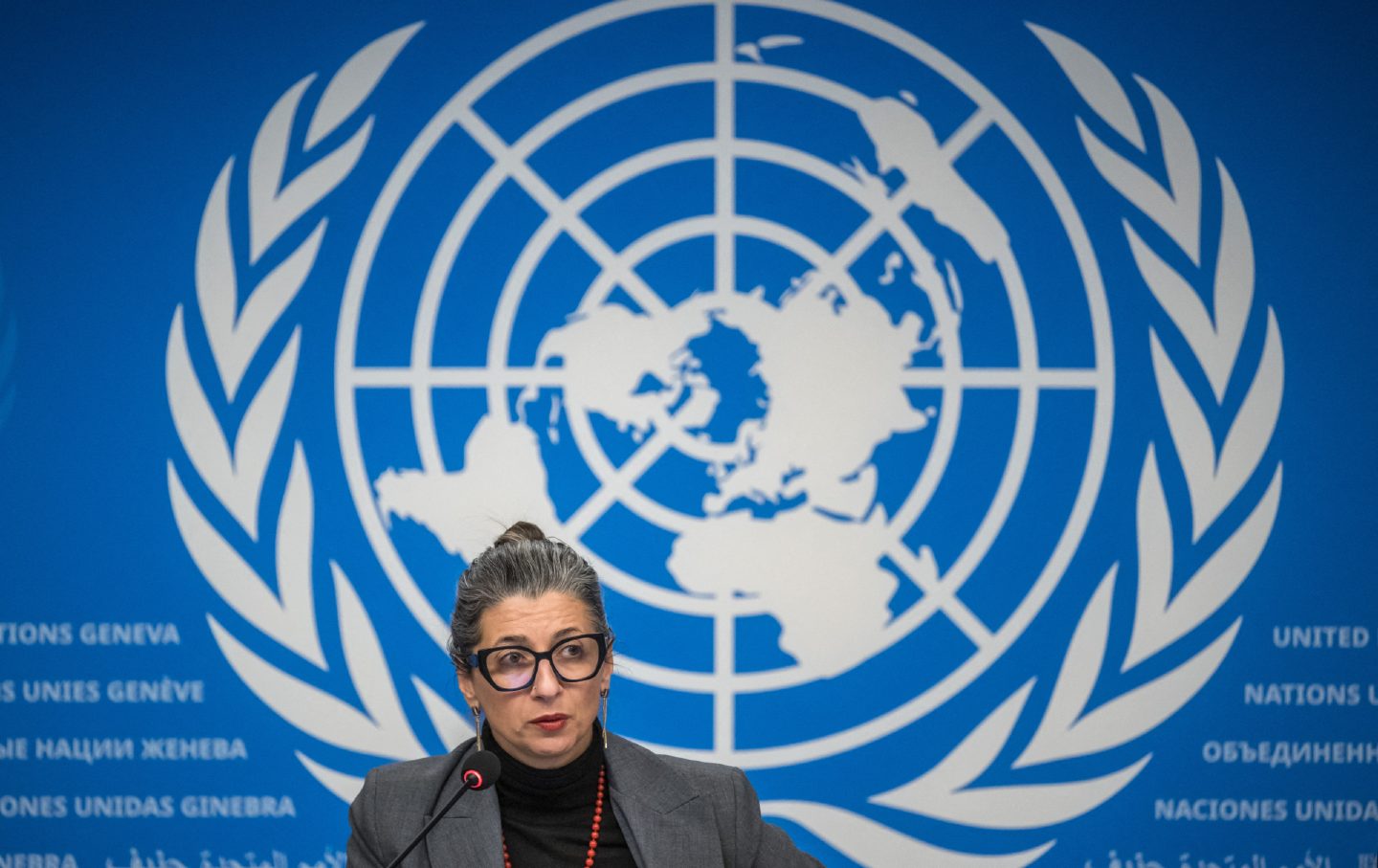
The Hague Group Must Become a Global Initiative The Hague Group Must Become a Global Initiative
The formation of The Hague Group is a critical step toward saving the international legal order. More states need to follow through to ensure the end of systemic impunity.
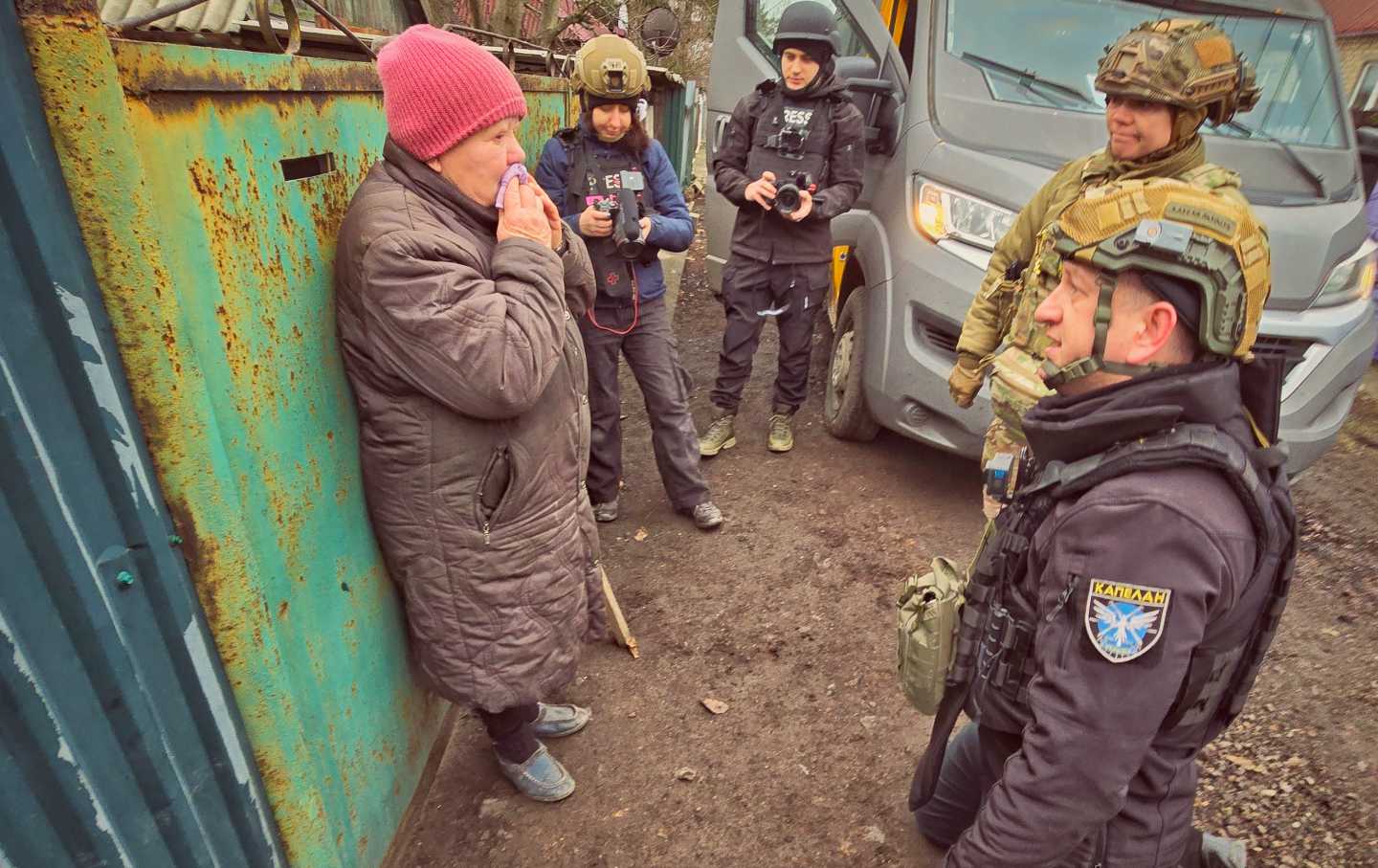
A Priest Races to Rescue Civilians as Russian Forces Close In A Priest Races to Rescue Civilians as Russian Forces Close In
Meet Leonid Nomerchuk, the 39-year-old priest evacuating civilians from Ukrainian villages under Russian missile and drone attack.
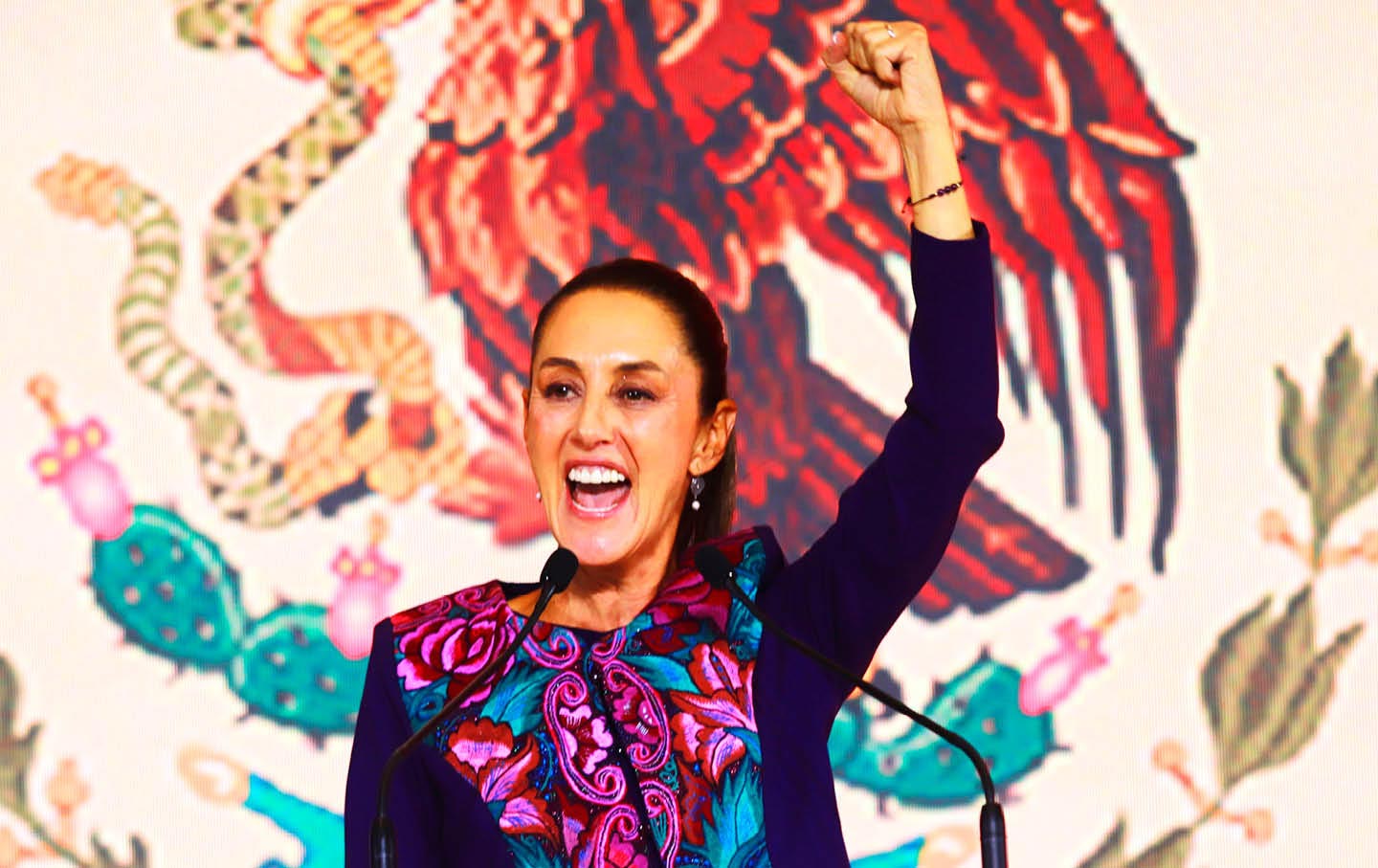
Morena and Claudia Sheinbaum Have Kept Up Mexico’s Move to the Left Morena and Claudia Sheinbaum Have Kept Up Mexico’s Move to the Left
Incumbent parties around the world keep losing to upstart challengers. Yet Mexico’s López Obrador defied the trend, handing off his presidency to Sheinbaum. What’s their secret?
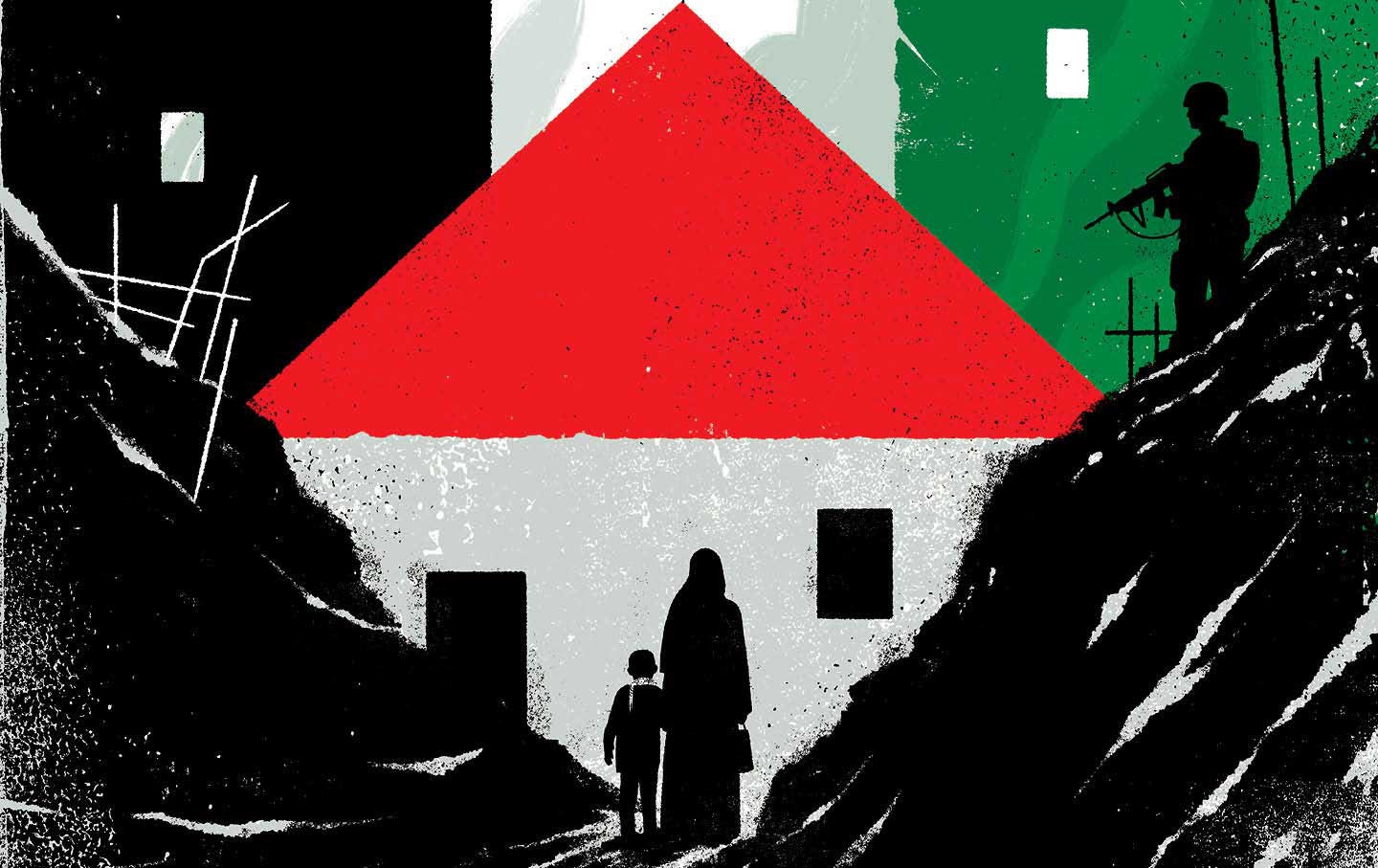
The Settler Plot to Recolonize Gaza The Settler Plot to Recolonize Gaza
Since Israel invaded Gaza in 2023, far-right settlers have set their sights on the Strip—and they have no intention of letting a ceasefire stand in their way.
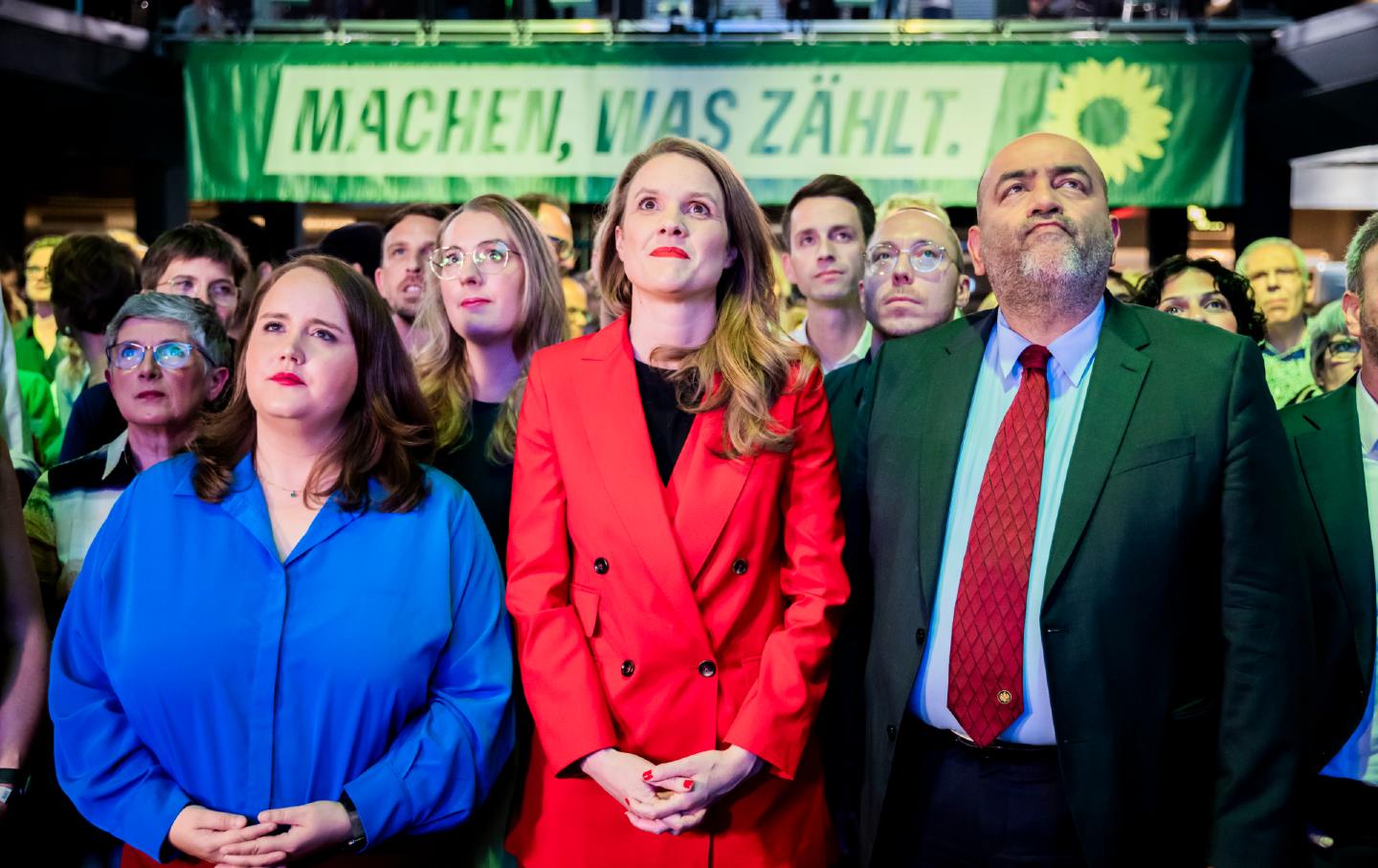
How the Greens Became the Driving Force of German Militarism How the Greens Became the Driving Force of German Militarism
The Greens, founded as a pacifist party, are now enthusiastic cheerleaders for rearmament.
